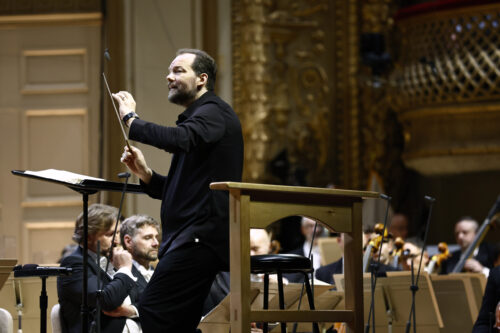 United States Mahler, Symphony No.8: Soloists, Tanglewood Festival Chorus (conductor: James Burton), Boys of the Saint Paul’s Choir School (music director: Brandon Straub), Boston Symphony Orchestra / Andris Nelsons (conductor). Symphony Hall, Boston, 6.10.2024. (ES-S)
United States Mahler, Symphony No.8: Soloists, Tanglewood Festival Chorus (conductor: James Burton), Boys of the Saint Paul’s Choir School (music director: Brandon Straub), Boston Symphony Orchestra / Andris Nelsons (conductor). Symphony Hall, Boston, 6.10.2024. (ES-S)

Magna Peccatrix – Latonia Moore (soprano 1)
Una poenitentium – Christine Goerke (soprano 2)
Mater Gloriosa – Ying Fang (soprano 3)
Mulier Samaritana – Mihoko Fujimura (mezzo-soprano 1)
Maria Aegyptiaca – Gerhild Romberger (mezzo-soprano 2)
Doctor Marianus – Andreas Schager (tenor)
Pater Ecstaticus – Michael Nagy (baritone)
Pater Profundus – Ryan Speedo Green (bass-baritone)
A performance of Mahler’s Symphony No.8 with its colossal scale and ambitious reach is always a challenge for both interpreters and the public. The last of his works to premiere during his lifetime and bearing the label ‘Symphony of a Thousand’ – a title the composer never endorsed – it demands a vast interpretative apparatus: a massive orchestra, multiple choruses and vocal soloists. The symphony juxtaposes and weaves together two texts from distinct epochs: a medieval Latin hymn expressing a Christian belief in the power of the Holy Spirit, and the final scene of Goethe’s Faust Part II, originally written in German, that presents a poetic vision of humanity’s redemption through love. In addition, the Eighth is quite different from all the other symphonies in Mahler’s canon. A triumphal return to the integration of song within the symphonic structures, which Mahler had abandoned in the three more cohesive and abstract symphonies leading up to it, the Symphony No.8 is predominantly optimistic and celebratory, avoiding the frequent shifts between existential doubt and hope that define much of composer’s output.
The Boston Symphony has not performed this Mahler work since its 2005 Tanglewood season under the baton of the late James Levine (Nelsons himself conducted the young fellows of the Tanglewood Music Center in 2015). I initially thought the Sunday afternoon Symphony Hall performance might get a little blasé, as it was the third presentation on consecutive days. Thankfully, one only had to witness the palpable emotion on Christine Goerke’s and Andreas Schager’s faces to realize how wrong I was!
Nevertheless, although the performers’ enthusiasm was evident, the overall rendition was far from an unqualified success. Despite being one of the best concert halls in the Americas, Boston’s Symphony Hall is not an ideal venue for these types of sonorities, even if the total number of musicians involved was far from the legendary thousand. The first part, in particular, suffered from sonic imbalances. At times, the strings and the boys’ choir were barely audible. Harmony among the vocal soloists in their tuttis was also disrupted by individuals attempting to project their powerful instruments – heldentenor Andreas Schager being a notable example – above the others.

The first part, structured in Sonata–Allegro form, opened with a powerful E-flat major organ chord that filled the space, immediately giving way to the contrapuntal choral presentation of the ‘Veni Creator Spiritus’ hymn. It ended in a whirlwind of sound, unleashing the full force of the orchestra. In between, moments of beauty – such as the dialogue between the newly promoted First Associate Concertmaster Alexander Velinzon and the choir – were interspersed with instances where the ensemble’s cohesion noticeably faltered.
After a brief cesura, the performance of the second part proved undeniably more successful, showcasing several outstanding individual vocal contributions. Soprano Ying Fang as Mater Gloriosa floated her angelic yet penetrating voice, suavely accompanied by harmonium, harps and strings during a brief intervention from the second balcony. Soprano Christine Goerke sustained her strong contributions from the first part as Faust’s Gretchen, now transformed into Una poenitentium. She controlled her powerful voice marvelously, infusing her supplications with heart-wrenching lyricism.
Another great Wagnerian, Andreas Schager, redeemed himself from the shortcomings of the first part, navigating Doctor Marianus’s mischievously high tessitura with ease. He conveyed a genuine sense of line and flow in his rendition of ‘Jungfrau, rein im schönsten Sinn’ (‘Virgin of the highest purity’), a paean to the Mater Gloriosa. Evoking scenes of natural beauty in a manner reminiscent of Das Knaben Wunderhorn, bass-baritone Ryan Speedo Green employed his deep, dignified voice to great effect. Mezzo-soprano Mihoko Fujimura portrayed the Samaritan Woman with quiet confidence. Completing the strong cast, soprano Latonia Moore, mezzo Gerhild Romberger and baritone Michael Nagy made their own distinctive contributions to the quasi-operatic second part.
From conjuring a rocky landscape to allowing the ‘Chorus Mysticus’ to emerge from a dreamlike haze, Andris Nelsons expertly paced the entire second part of the symphony, bringing its details to the forefront with clarity. An experienced Mahlerian, he illuminated not only the musical links between the two seemingly disjointed parts of the symphony, but also references to the composer’s earlier works. In his vision, Mahler’s Symphony No.8 is not an oddity, but a culmination of previous efforts to create an integrated musical world, one that embraces orchestral songs, dramatic cantatas and sacred oratorios. Unfortunately, the path taken to communicate this vision was full of asperities.
Edward Sava-Segal

Mahler’s Eighth can’t be pigeonholed because it’s not the next work of the middle period nor the first work of the last period. It’s in between both and gives us a tantalizing glimpse into what Mahler’s third period would have been like had he lived longer. It’s a world unto itself. Then came the triple crisis of 1907: Mahler was forced to resign as director of the Vienna Opera; one of his daughters died; and he was diagnosed with heart disease. After that, he entered his late period, with three farewells to life.